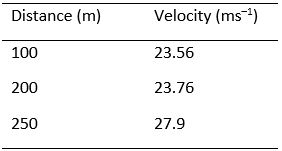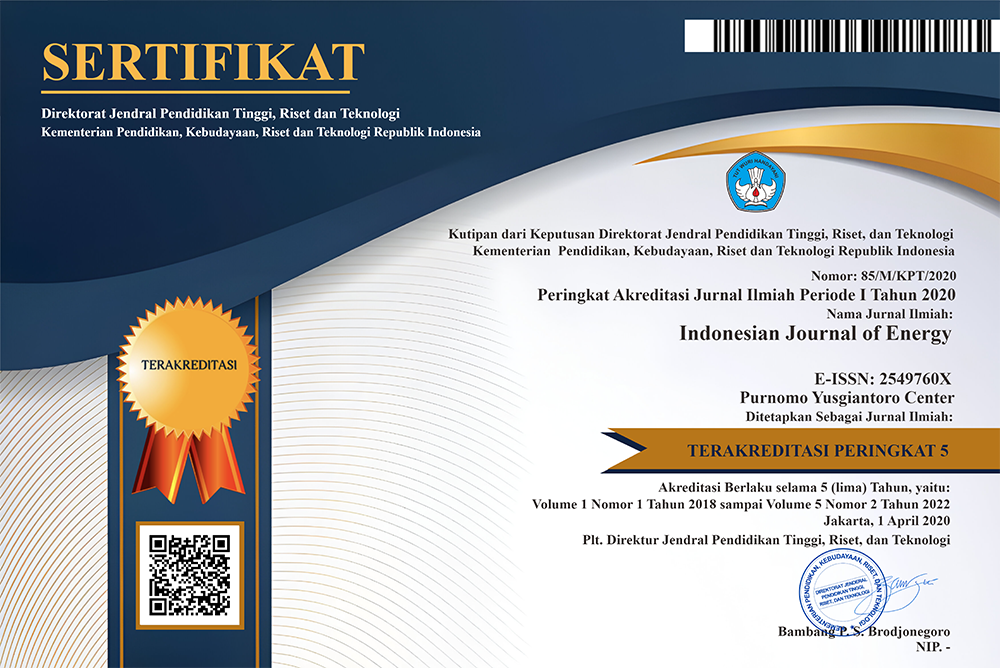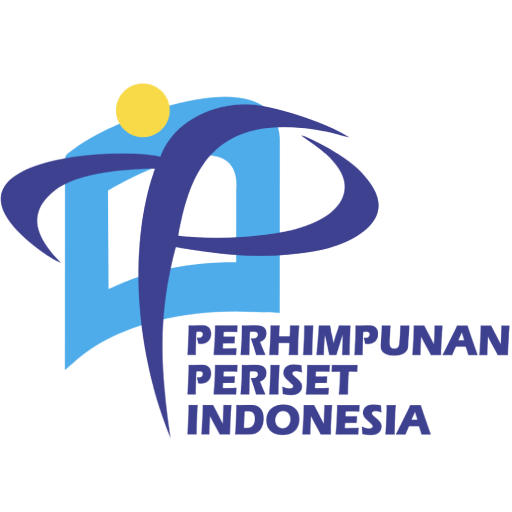 |
 |
 |
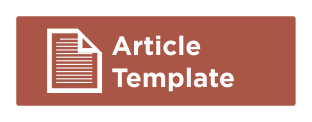 |
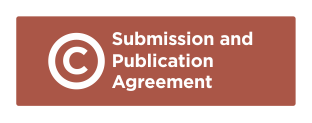 |
 |
Author Guidelines
BEFORE YOU BEGIN
Ethics in Publishing
Before submitting your manuscript, please read the Indonesian Journal of Energy (IJE) Publication Ethics and Malpractice Statements here.
Authorship
Each author must have a substantial contribution to at least one role within the CRediT taxonomy, encompassing Conceptualization; Data curation; Formal analysis; Funding acquisition; Investigation; Methodology; Project administration; Resources; Software; Supervision; Validation; Visualization; Roles/Writing - original draft; and Writing - review & editing. Authors may hold multiple roles, and not all roles need to be fulfilled.
Changes to Authorship
Authors are advised to thoughtfully consider the list and order of authors prior to submitting their manuscript. The definitive list of authors should be provided at the time of the original submission. Changes to authorship (including addition, removal, and rearrangement) can be made before the manuscript is accepted. Changes should be made through an official letter or email request that explains the reasons for the change and is signed by all the authors listed in the original submitted manuscript. Changes to authorship after the manuscript has been accepted can only be made under special circumstances, as described in an official letter or email request signed by all authors listed in the original submitted manuscript. If the manuscript has already been published online, any requests approved by the Editor will lead to a corrigendum.
Author(s) Rights
For the rights of the Author(s) to reuse his/her work, please refer to our Publication Ethics and Malpractice Statement page here.
Language
The manuscript must use well written and grammatically correct English. You can use American or British English, as long as it is consistent throughout the manuscript. The use of poor English can result in manuscript rejection. When needed, you can use the help of English writing tools, generative artificial intelligence (AI)/ AI-assisted technologies, a professional translator or editor. Please do spell-check and grammar-check on your manuscript carefully.
In addition, please use inclusive language. Inclusive language means acknowledgment of diversity, conveys respect to all people, is sensitive to differences and promotes equal opportunities. Author(s) should ensure that writing is free from bias, stereotypes, slang, a reference to the dominant culture and/or cultural assumptions. Please refrain from using descriptors that refer to personal attributes such as age, gender, race, ethnicity, culture, sexual orientation, disability or health condition unless they are necessary, relevant and valid. These guidelines are not exhaustive or definitive by no means and are meant to guide you in the writing process.
Online Submission
Submission to this journal is conducted through an online system at https://ije-pyc.org/index.php/IJE/login. You are required to create a new account or log in with your existing account. The login page also serves as a platform to check the submission status.
Please submit your manuscript in the .docx format (Microsoft Word format) and drop your manuscript in the upload box. The manuscript should have a corresponding author, responsible for communication, is identified with the following contact details:
- Postal Address
Peer Review Policy
For the peer review policy, please refer to our Peer Review Policy page here.
Revised Submissions
Manuscripts requiring revision will be communicated via email. Please submit the revised manuscript in an editable format (.docx) after completion. To minimize errors, it is recommended to use a grammar checking tool or seek guidance from a professional proofreader or editor for language-related issues.
Submission and Publication Agreement
When you submit your manuscript, you are expected to sign our submission and publication agreement form. If your manuscript is selected for publication, then you grant IJE the copyright to publish your manuscript. In principle, copyright of the manuscript still remains with you, the author (or co-Author(s)). When necessary, you must obtain permission to publish material protected by copyright before submitting the manuscript. Please read the Submission and Publication Agreement form here.
MANUSCRIPT STRUCTURE
To write your manuscript, please refer to IJE template which you can download here. The followings outline all the key information that should be included in your manuscript. Example on how to write your manuscript based on the following guideline can be seen on the template as well.
The main text of your manuscript should start on the same page as the abstract. The text should be indented 25.4 mm/1 inches from the left margin. Font size and formatting should use Times New Roman, 11 pt and single line spacing, with before and after spacing 0 pt.
Formatting requirements
Download the “Manuscript Template”
Manuscripts submitted to IJE must adhere to the following criteria:
- Aim/Scope: Clearly defines the aim and scope of the submission.
- Methodologies: Utilizes scientifically relevant methodologies, providing adequate descriptions.
- Novelty and Scientific Impact: Considers novelty and scientific impact, ensuring results are of interest to a specific niche or broad community.
- Originality: Presents original results that have not been published before.
- Conclusions: Supports conclusions with the presented data.
- Writing Quality: Demonstrates well-written and logically constructed content. The manuscript has undergone both spell checking and grammar checking.
- Reference: All references listed in the Reference List are appropriately cited in the text, and vice versa. The use of reference management software, such as EndNote and Mendeley, is strongly encouraged.
Meeting these criteria ensures that the manuscript is of high quality, contributes to the scientific community, and aligns with the standards of IJE.
Essential Title Page Information
Title. It should be concise and informative. Try to avoid abbreviations or formula if possible.
A list of all authors’ names and their affiliations. The order for the names is the given name, followed by the middle name (if there is one) in initials (with periods) and the family name. The authors’ affiliations follow the author’s list. If there is more than one affiliations then a superscripted number should come at the start of each address; each author should also have a superscripted number or numbers following their name to indicate which affiliations, or addresses, are the appropriate ones for them.
Corresponding author. Email address should be given for the corresponding author at the footer of the first page.
Abstract
The abstract should be positioned after the list of affiliations. The abstract should provide a concise and factual summary of the background, research objectives, methodology, data, results of analysis, conclusions, and research contributions. Since the abstract is a standalone section, it must be self-contained, devoid of table numbers, figure numbers, references, uncommon abbreviations, or displayed mathematical expressions.
Keywords
Following the abstract, the Author(s) must provide a maximum of 5 keywords, avoiding general and plural terms and multiple concepts (avoid, for example, 'and', 'of'). Keywords at least consist of two words. For example, do not use these kinds of keywords: renewable energy and development, economy of Indonesia. Be sparing with abbreviations: only abbreviations firmly established in the study may be eligible. In terms of format, please use only capital letters for the first keyword, unless the keyword is the name of a person, brand, country, etc. For example, Keywords: Renewable energy, geothermal fund, nuclear power, and Nash’s game theory. These keywords will be used for indexing purposes.
Numbered Sections
Please structure your manuscript into several sections and you are required to number them. The abstract is not included in section numbering. For numbering in the Section part, insert a number followed with a period and the Section name. Bold the section name and give one space (enter) in before and after text. For example: “1. Introduction”. For numbering the Subsection part, please insert the first number that indicates the section, followed by a period, a number that indicates the Subsection (with no period after subsection number) and then the Subsection title. The Subsection should be written in italic and given by one space (enter) before and after text, for example: “2.1 Research Methodology”. Both Section and Subsection should be capitalized for the first letter of each word, except for conjunction. The Introduction and Conclusions sections should not contain any subsections.
1. Introduction
This section should describe the research background, the research objectives, and the state of the art or contribution.
Please be aware that the Introduction section should not contain any subsections.
2. Methods and Materials
This section should provide the detailed methods and materials used to address the research problems. The methodology must be explained in detail to allow for the reproducibility of this study by an independent researcher. Methods that are already published should be summarized, and indicated by a reference. If quoting directly from a previously published method, use quotation marks and cite the source. Any modifications to existing methods should also be described.
3. Results and Discussions
The result should be concise, clear and answer the research objectives. Avoid excessive uses of citations and discussions from existing literature publications.
This section should explain how the analysis results address the research questions/objectives stated in the Introduction section, interpret the research findings, and compare the analysis results with those of other similar studies. It should also elucidate the significance of the research.
4. Conclusion
The main conclusion should be articulated in clear and concise paragraphs, summarizing research objectives, methodology, and results. It should also elucidate the research's contribution to academic literature and policies. In this section, authors may suggest or advise improvements for future research.
Acknowledgments
Collate acknowledgments in a separate section at the end of the manuscript before the references and do not include them on the title page, as a footnote to the title. List in the Acknowledgements, those who provided help during the research (e.g., providing language help, writing assistance, proofreading the manuscript, etc.). You can also acknowledge any fundings or grants that enable you to conduct the research.
Formatting of funding sources
List funding sources in a standard way to facilitate compliance to funder's requirements, as for example:
“Funding: This work was supported by the National Institutes of Health [grant numbers xxxx, yyyy]; the Bill & Melinda Gates Foundation, Seattle, WA [grant number zzzz]; and the United States Institutes of Peace [grant number aaaa].”
It is not necessary to include detailed descriptions on the program or type of grants and awards. When funding is from a block grant or other resources available to a university, college, or other research institution, submit the name of the institute or organization that provided the funding.
If no funding has been provided for the research, please include the following sentence:
“This research did not receive any specific grant from funding agencies in the public, commercial, or not-for-profit sectors.”
References
We advise you to use a reference manager tool, such as Mendeley software. IJE uses the American Psychological Association (APA) style for the reference and in-text citation. Please check the website of APA here for more details.
A complete reference should provide enough information to locate the manuscript mentioned in the printed or digital form. If you are unsure of a particular journal’s abbreviated title, it is best to leave the title in full. The terms loc. cit. and ibid. should not be used.
Please Note:
- Please ensure that your manuscript includes a minimum of twenty (20) references.
- Out of these references, at least 60% from the references should be articles indexed in Scopus.
- We strongly recommend citing articles published within the last ten (10) years (at least 80% of the references).
- 80% of the references should be from primary sources, such as journals, proceedings, dissertations, and thesis (books not included as primary sources). If the manuscript uses the website as additional references, please use the website from the formal institution (exclude personal website/blog).
The following is example of the references using APA style.
References
Aswadi, K., Jamal, A., Syahnur, S., & Nasir, M. (2023). Renewable and non-renewable energy consumption in Indonesia: Does it matter for economic growth? International Journal of Energy Economics and Policy, 13(2), 107–116. https://doi.org/10.32479/ijeep.13900
Budihardjo, M. A., Humaira, N. G., Ramadan, B. S., Wahyuningrum, I. F. S., & Huboyo, H. S. (2023). Strategies to reduce greenhouse gas emissions from municipal solid waste management in Indonesia: The case of Semarang City. Alexandria Engineering Journal, 69, 771–783. https://doi.org/10.1016/j.aej.2023.02.029
Buijze, L, et al. (2019). Review Of induced seismicity in geothermal systems worldwide and implications for geothermal systems in the Netherlands. Netherlands Journal of Geosciences, 98(13). https://doi.org/10.1017/njg.2019.6
Dewi, C. N., Maryanto, S., & Rachmansyah, A. (2015). Sistem panasbumi daerah Blawan, Jawa Timur berdasarkan survei magnetotelurik. Jurnal RISET Geologi dan Pertambangan, 25(2), 111–119. https://doi.org/10.14203/risetgeotam2015.v25.262
Mikhaylov, A., Moiseev, N., Aleshin, K., & Burkhardt, T. (2020). Global climate change and greenhouse effect. Entrepreneurship and Sustainability Issues, 7(4), 2897–2913. https://doi.org/10.9770/jesi.2020.7.4(21)
Please visit the APA website for complete information and guide here.
Appendices
Author(s) may add any appendices, if any, at the end of the manuscript. Appendices includes supporting data, i.e. additional information, data files, tables of extra information or extra figures. If there is more than one Appendix, Author(s) may specifically identify them as A, B, etc. Formulae and equations in appendices or subsequent appendix (A.1, A.2, B.1 and so on) should be given by a separate numbering: Eq. (A.1), Eq. (A.2), etc. Similarly for tables and figures: Table A.1; Fig. A.1, etc.
Miscellaneous
Abbreviations
Please provide the full form of the abbreviations that are not commonly used in a footnote. You can also give a brief explanation of what the abbreviations mean. Such abbreviations that are unavoidable in the abstract must be defined the first time they are mentioned, as well as in the footnote. Please ensure the consistency of abbreviations throughout the manuscript.
Footnotes
Footnotes should be used sparingly. Number them consecutively throughout the manuscript. Many word processors build footnotes into the text, and this feature may be used. Should this not be the case, indicate the position of footnotes in the text and present the footnotes themselves separately at the end of each page.
Units
Follow internationally accepted rules and conventions: use the international system of units (SI). Please take care that all terminology and notation used will be widely understood. Abbreviations and acronyms should be spelled out in full at their first occurrence in the text. Please use a decimal point to separate comma, and comma to separate thousands (i.e. 1.606 for one point six hundres and six; 1,600 for one thousand and six hundreds). These are some examples on how to write units in a correct form:
- USD 50
- 80 tons
- 1,500 bopd
- 20 km
- IDR 1,000
- 8 liters
- 300 GW
- 80 0C
- 469 MWh
- 2,000 Mbtu
- etc.
Math formulae
Please submit math equations as editable text and not as images. Present simple formulae in line with normal text where possible and use the solidus (/) instead of a horizontal line for small fractional terms, e.g., X/Y. In principle, variables are to be presented in italics. Powers of “e” are often more conveniently denoted by exp. Please cite all the equations given in the text; otherwise please put them in the Appendix. Number any equations consecutively using a bracket () and use center alignment, regardless of the subsection they are in. For example, see the following:
A + B = C (1)
A/B = E (2)
Figures
All figures should be embedded in a correct position within your manuscript, and should also be sent as separate graphics files in their original formats. EPS, TIFF, PSD or PDF formats are preferred. Please use a minimum of 300 dpi pictures the image is submitted in the form of JPEG or PNG files.
Figures should appear in numerical order, be described and mentioned in the body of the text and be positioned close to where they are first cited; otherwise put them in the Appendix. Each figure should have a caption which describes the illustration, and that can be understood independently of the main text. The caption should be given in the text format, not as an image.
Figure Color
There are no restrictions on the use of color in the digital version of your manuscript. However, you should bear in mind that any printed version of your manuscript is likely to be in black and white which may make colored lines difficult to distinguish.
Figure Caption and Number
Captions should be below the figure and separated from it, in a text format. Figures should be numbered sequentially throughout the manuscript, e.g., Figure 1., Figure 2., etc, and should be referred to in the text as Figure 1, Figure 2, and not fig. 1, fig. 2, etc. Captions should be written in Times New Roman, 11 pt, and figures number should be written in Bold.
For captions below the figure, it should be set to the width of the figure for wider figures, centred across the width of the figure. Meanwhile, for narrow figures with wide captions, slightly extended beyond the width of the figure. The caption should finish with a full stop (period).
Example
The following examples show the appropriate format for figure’s position and caption.

Figure 3. Figure with short caption (caption centred).
 |
Figure 4. This is a figure with a caption that is wider than the actual graphic. To save space you can put the caption to the right side of the figure, by placing the graphic and justified caption in a table with one row and two columns. |
If a figure is divided into parts, these should be labelled (a), (b), (c) etc. but there should only be one caption for the whole figures, not separate ones for each part.
Figure 5. First figure (a), second figure (b) and third figure (c).
Table
Please submit tables as editable text and not as images. Number the tables consecutively, in accordance with their appearance in the text and place any table notes below the table body.
Tables should appear in numerical order, be described and mentioned in the body of the text and be positioned close to where they are first cited; otherwise put them in the Appendix. Be sparing in the use of tables and please avoid using vertical lines. Each table should have a caption which describes the data, and that can be understood independently of the main text. The caption should be given in the text format, not as an image.
Table Caption and Number
Tables should be centred unless they occupy the full width of the text. Tables should be numbered sequentially throughout the manuscript e.g., Table 1., Table 2., etc, and should be referred to in the text as Table 1, Table 2, and not tab. 1, tab. 2, etc. Captions should be placed at the top of the table, centered and should have a full stop (period) at the end. Except for very narrow tables with a wide caption (see the example below for Table 1) the caption should be the same width as the table. Captions should be written on 11 point and Table number should be boldly written.
Lines in Tables
Tables should have only horizontal lines and no vertical lines. Generally, only three lines should be used: one at the top of the table, one at the bottom, and one to separate the entries from the column headings. Table lines should be 0.5 pt wide.
Example
Because tables can take many forms, it is difficult to provide detailed guidelines; however, the following examples demonstrate our preferred styles.
Table 1. A simple table. Place the caption above the table. Here the caption is wider than the table so we extend it slightly outside the width of the table. Justify the text. Leave 6 pt of space between the caption and the top of the table.
If a table is divided into parts, these parts should be labelled (a), (b), (c), etc. However, there should only be one caption for the whole table, not separate ones for each part.
Table 1. A simple table with condition 1 (a), condition 2 (b) and condition 3 (c). Place the caption above the table. Justify the caption. Leave 6 pt of space between the caption and the top of the table.
Research Data
We encourage and enable you to share data that support your research publication where appropriate. We also allow you to interlink the data with your published manuscripts. Research data refers to the results of observations or experimentation that validate research findings. To facilitate reproducibility and data reuse, we also encourage you to share your software, code, models, algorithms, protocols, methods and other useful materials related to the research. To accommodate this part, we kindly ask you to put it specifically in the Appendix.
To support transparency, we encourage you to state the availability of your data for publicity. This may be a requirement of your funding body or institution. If your data is unavailable to access or unsuitable to post, you are required to inform us during the submission process, for example by stating that the research data is confidential.
Supplementary Materials
We encourage the Author(s) to submit supplementary data attachments to enhance the digital versions of published manuscripts. Supplementary materials typically consist of video clips, animations or supplementary data such as data files, tables of extra information or extra figures.
SUBMISSION CHECKLIST
Before submitting your manuscript, please check the followings:
- Ensure that the information of the corresponding author is complete: email address and full postal address;
- The manuscript is original and has not been published or considering being published elsewhere;
- The manuscript file complies with the given template and has been saved in a .docx format;
- The manuscript has been 'spell-checked' and 'grammar-checked'. You can use a grammar checking tool or consult with a professional translator or editor;
- References use APA style;
- All references mentioned in the Reference list are cited in the text, and vice versa;
- Permission has been obtained for the use of copyrighted material from other sources (including the internet).
AFTER ACCEPTANCE
E-certificate
After the manuscript has followed the process review successfully and is accepted to be published, IJE editorial team will inform the corresponding author through email. The IJE editorial team will send an e-certificate to the corresponding author, including all the co-Author(s) as a token of appreciation. This e-certificate will consist each of the (co)-author’s name, title and DOI of the manuscript. The online published manuscript can be freely accessed and downloaded from the IJE website.
Author(s) Inquiries
For more information, please contact:
Editorial Board - Indonesian Journal of Energy (IJE), Purnomo Yusgiantoro Center (PYC)
Jl. Wijaya IX No.12, RT.2/RW.5, Kelurahan Melawai, Kecamatan Kebayoran Baru, Kota Jakarta Selatan, Daerah Khusus Ibukota Jakarta 12160
Tel: +62 (21) 7203917
Whatsapp: +62 811 1888 932
Email: ije@pycenter.org


